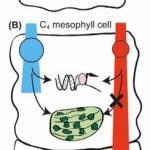Plant Science Research Weekly: January 3rd
Review: The nanoscale organization of the plasma membrane and its importance in signaling – a proteolipid perspective
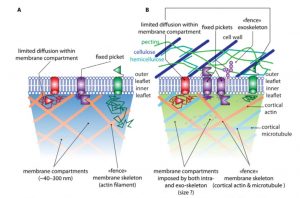 Ample evidence shows that rather than being homogenous, plasma membrane lipids and proteins form distinct nanodomains. Jallais and Ott review plant plasma membrane nanodomains, and their important contributions to receptor-mediated signaling. The authors discuss methods for the study of membrane nanodomains, and their function and composition including the roles of flotillins and plant-specific remorins. Lipids, particularly phophoinisotides (PIs), clearly contribute to nanodomain formation, but details are still being elucidated. Clustering of receptor proteins in distinct membrane domains may serve to amplify signals and/or facilitate endocytosis. The authors also describe the “anchored picket fence model” in which anchor points of the cytoskeleton restrict lateral diffusion of the lipids and proteins, and the concept of the plasma membrane as a screen or integrator of external signals. (Summary by Mary Williams) Plant Physiol. 10.1104/pp.19.01349
Ample evidence shows that rather than being homogenous, plasma membrane lipids and proteins form distinct nanodomains. Jallais and Ott review plant plasma membrane nanodomains, and their important contributions to receptor-mediated signaling. The authors discuss methods for the study of membrane nanodomains, and their function and composition including the roles of flotillins and plant-specific remorins. Lipids, particularly phophoinisotides (PIs), clearly contribute to nanodomain formation, but details are still being elucidated. Clustering of receptor proteins in distinct membrane domains may serve to amplify signals and/or facilitate endocytosis. The authors also describe the “anchored picket fence model” in which anchor points of the cytoskeleton restrict lateral diffusion of the lipids and proteins, and the concept of the plasma membrane as a screen or integrator of external signals. (Summary by Mary Williams) Plant Physiol. 10.1104/pp.19.01349
Review: Tomato fruit water accumulation and solute metabolism under water shortage
 Deficit irrigation is water-conserving strategy in which a growing plant is given just enough but never too much water. Previous studies have shown myriad physiological changes caused by deficit irrigation including decreased growth rate and shoot:root ratio, and also a lower fruit water content. Here, Hou et al. review tomato fruit quality grown under deficit irrigation. Water deficit affects solute transport, metabolism, and water relations between fruit and parent plant, all of which are explored in terms of how they affect tomato fruit size, nutritional and flavor qualities, and firmness. The authors also address how genetic variation affects the fruit responses to deficit irrigation. (Summary by Mary Williams) J. Exp. Bot. 10.1093/jxb/erz526
Deficit irrigation is water-conserving strategy in which a growing plant is given just enough but never too much water. Previous studies have shown myriad physiological changes caused by deficit irrigation including decreased growth rate and shoot:root ratio, and also a lower fruit water content. Here, Hou et al. review tomato fruit quality grown under deficit irrigation. Water deficit affects solute transport, metabolism, and water relations between fruit and parent plant, all of which are explored in terms of how they affect tomato fruit size, nutritional and flavor qualities, and firmness. The authors also address how genetic variation affects the fruit responses to deficit irrigation. (Summary by Mary Williams) J. Exp. Bot. 10.1093/jxb/erz526
Review: Genebank genomics bridges the gap between the conservation of crop diversity and plant breeding
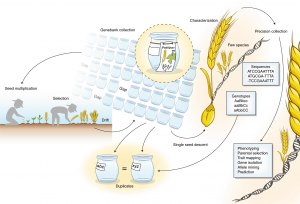 Crop diversity is fundamental to safeguarding global food security. The high-yielding, input-responsive cultivars developed post-green revolution led to the replacement of traditional landraces that harbour beneficial genes and alleles governing biotic and abiotic stress resistance and nutritional quality improvement. Genebanks conserve these invaluable plant genetic resources (PGRs) for future crop improvement. The review by Masher et al. is a beautiful narration of the author’s vision for the transformation of genebanks into bio-digital resource centres through application of genomic approaches in genebank management and pre-breeding activities. Molecular data on single nucleotide polymorphisms obtained through high-throughput genotyping platforms can complement the conventional passport records in defining the identity of the collections. Duplicate accessions that escalate the cost and workload to genebank managers can be cleansed through identity-by-state analyses using marker data from large number of individuals. As phenotyping the entire collection for complex traits like yield and quality is burdensome, initial core sets can be created based on maximized neutral genetic diversity using the marker data. The phenotypes of the remaining accessions can be imputed from the prediction models developed using the phenotypes of the core sets coupled with marker data. Genome wide association mapping using such core sets would directly lead to the identification of the candidate gene. This can be followed by allele mining to determine allelic diversity in the collections. The promising genotypes thus identified with superior alleles can be crossed to modern breeding lines, and speed breeding technologies could hasten the development of commercial varieties. (Summary by Haritha Bollinedi) Nature Genetics 10.1038/s41588-019-0443-6
Crop diversity is fundamental to safeguarding global food security. The high-yielding, input-responsive cultivars developed post-green revolution led to the replacement of traditional landraces that harbour beneficial genes and alleles governing biotic and abiotic stress resistance and nutritional quality improvement. Genebanks conserve these invaluable plant genetic resources (PGRs) for future crop improvement. The review by Masher et al. is a beautiful narration of the author’s vision for the transformation of genebanks into bio-digital resource centres through application of genomic approaches in genebank management and pre-breeding activities. Molecular data on single nucleotide polymorphisms obtained through high-throughput genotyping platforms can complement the conventional passport records in defining the identity of the collections. Duplicate accessions that escalate the cost and workload to genebank managers can be cleansed through identity-by-state analyses using marker data from large number of individuals. As phenotyping the entire collection for complex traits like yield and quality is burdensome, initial core sets can be created based on maximized neutral genetic diversity using the marker data. The phenotypes of the remaining accessions can be imputed from the prediction models developed using the phenotypes of the core sets coupled with marker data. Genome wide association mapping using such core sets would directly lead to the identification of the candidate gene. This can be followed by allele mining to determine allelic diversity in the collections. The promising genotypes thus identified with superior alleles can be crossed to modern breeding lines, and speed breeding technologies could hasten the development of commercial varieties. (Summary by Haritha Bollinedi) Nature Genetics 10.1038/s41588-019-0443-6
Opinion. A return to the wild: Root exudates and food security
 My dog is a fantastic companion, but it’s obvious he could never fend for himself; domestication has eliminated his ancestral survival skills. Likewise, most crop plants thrive under human care, but have lost many of the traits that would help them survive in harsh conditions. Preece and Peñuelas write a compelling article pointing out that re-introducing some of these survival trait to crops could make farming more sustainable. They observe that selection for high yields has generally decreased the amount of material exuded into soil by roots, but these root exudates enable plants to recruit symbionts (allowing for less fertilizer use) and deter pathogens (allowing for less pesticide use). Challenges lie in the difficulty in reliably quantifying root exudates, and their inherent variability. (Summary by Mary Williams) Trends Plant Sci. 10.1016/j.tplants.2019.09.010
My dog is a fantastic companion, but it’s obvious he could never fend for himself; domestication has eliminated his ancestral survival skills. Likewise, most crop plants thrive under human care, but have lost many of the traits that would help them survive in harsh conditions. Preece and Peñuelas write a compelling article pointing out that re-introducing some of these survival trait to crops could make farming more sustainable. They observe that selection for high yields has generally decreased the amount of material exuded into soil by roots, but these root exudates enable plants to recruit symbionts (allowing for less fertilizer use) and deter pathogens (allowing for less pesticide use). Challenges lie in the difficulty in reliably quantifying root exudates, and their inherent variability. (Summary by Mary Williams) Trends Plant Sci. 10.1016/j.tplants.2019.09.010
Over‐accumulation of abscisic acid in transgenic tomato plants increases the risk of hydraulic failure
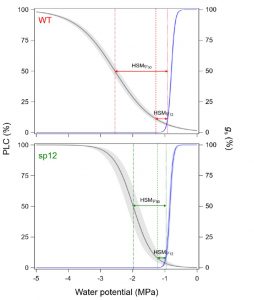 ABA enhances stomatal closure and so decreases transpiration. Several studies have shown that increasing ABA levels can increase water-use efficiency, so this strategy has been investigated with the goal of obtaining “more crop per drop”. Lamarque et al. investigated physiological and hydraulic effects of a tomato variety (sp12) overproducing ABA, starting with the hypothesis that ABA overproduction would decrease the risk of hydraulic failure. Instead, they found that the ABA-overproducing lines showed an increased risk of hydraulic failure, with xylem embolisms occurring at less-negative water potentials. Their data show that the transgenic ABA-overproducing lines “could have a narrower hydraulic safety margin, a lower capacity to maintain stem hydraulic conductivity, and subsequently a higher risk of mortality under drought.” As yet, the mechanistic relationship between ABA and vulnerability to embolism formation is not known, but it could involve xylem morphology or aquaporin function. (Summary by Mary Williams) Plant Cell Environ. 10.1111/pce.13703
ABA enhances stomatal closure and so decreases transpiration. Several studies have shown that increasing ABA levels can increase water-use efficiency, so this strategy has been investigated with the goal of obtaining “more crop per drop”. Lamarque et al. investigated physiological and hydraulic effects of a tomato variety (sp12) overproducing ABA, starting with the hypothesis that ABA overproduction would decrease the risk of hydraulic failure. Instead, they found that the ABA-overproducing lines showed an increased risk of hydraulic failure, with xylem embolisms occurring at less-negative water potentials. Their data show that the transgenic ABA-overproducing lines “could have a narrower hydraulic safety margin, a lower capacity to maintain stem hydraulic conductivity, and subsequently a higher risk of mortality under drought.” As yet, the mechanistic relationship between ABA and vulnerability to embolism formation is not known, but it could involve xylem morphology or aquaporin function. (Summary by Mary Williams) Plant Cell Environ. 10.1111/pce.13703
A SAC phosphoinositide phosphatase controls rice development via hydrolyzing PI4P and PI(4,5)P2
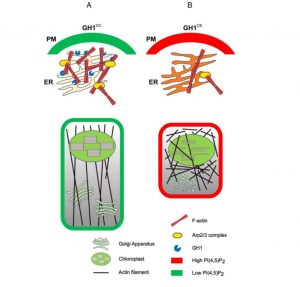 As their name suggests, phosphoinositide (PI) phosphatases remove phosphates from phosphoinositides (try saying that fast!). Because the phosphorylation status of a membrane-bound PI determines which proteins it interacts with, PI phosphatases and kinases contribute to membrane functions and dynamics. Here, Guo et al. explore the function of a SAC family PI phosphatase, which they identified through a mapping study as GRAIN NUMBER AND PLANT HEIGHT1 (GH1). In the rice variety CB, there is a premature stop codon in the gene that renders it nonfunctional, leading to an overaccumulation of PI4P and PI(4,5)P2, as well as abnormalities in the actin cytoskeleton and vesicle trafficking. In vitro studies suggest that the Arp2/3 complex, which functions as a nucleator of actin filament dynamics, might be the target of the elevated levels of PIs. (Summary by Mary Williams) Plant Physiol. 10.1104/pp.19.01131
As their name suggests, phosphoinositide (PI) phosphatases remove phosphates from phosphoinositides (try saying that fast!). Because the phosphorylation status of a membrane-bound PI determines which proteins it interacts with, PI phosphatases and kinases contribute to membrane functions and dynamics. Here, Guo et al. explore the function of a SAC family PI phosphatase, which they identified through a mapping study as GRAIN NUMBER AND PLANT HEIGHT1 (GH1). In the rice variety CB, there is a premature stop codon in the gene that renders it nonfunctional, leading to an overaccumulation of PI4P and PI(4,5)P2, as well as abnormalities in the actin cytoskeleton and vesicle trafficking. In vitro studies suggest that the Arp2/3 complex, which functions as a nucleator of actin filament dynamics, might be the target of the elevated levels of PIs. (Summary by Mary Williams) Plant Physiol. 10.1104/pp.19.01131
Plasma membrane domain patterning and self-reinforcing polarity in Arabidopsis
 Phosphoinositides (PIs) are specialized membrane lipids that contribute to membrane nanodomains, which affect protein localizations and vesicle trafficking. Previous studies have implicated PIs in the polar localization of auxin-transporter PIN proteins, and, in roots, the PIN-regulators PAX and BRX. Here, Marhava et al. show that BRX and PAX recruit phosphatidylinositol-4-phosphate 5-kinases [PIP5Ks; kinases that convert PI4P to PI(4,5)P2] to the rootward plasma membrane, thus altering the abundance of PI(4,5)P2. Because PI(4,5)P2 promotes PAX plasma membrane association, local PI(4,5)P2 biosynthesis reinforces the polarity of all three components. Furthermore, elevated PI(4,5)P2 promotes PIN endocytosis. Thus, BRX, PAX, and PIP5Ks constitute a self-reinforcing polarity module. (Summary by Mary Williams) Devel. Cell 10.1016/j.devcel.2019.11.015
Phosphoinositides (PIs) are specialized membrane lipids that contribute to membrane nanodomains, which affect protein localizations and vesicle trafficking. Previous studies have implicated PIs in the polar localization of auxin-transporter PIN proteins, and, in roots, the PIN-regulators PAX and BRX. Here, Marhava et al. show that BRX and PAX recruit phosphatidylinositol-4-phosphate 5-kinases [PIP5Ks; kinases that convert PI4P to PI(4,5)P2] to the rootward plasma membrane, thus altering the abundance of PI(4,5)P2. Because PI(4,5)P2 promotes PAX plasma membrane association, local PI(4,5)P2 biosynthesis reinforces the polarity of all three components. Furthermore, elevated PI(4,5)P2 promotes PIN endocytosis. Thus, BRX, PAX, and PIP5Ks constitute a self-reinforcing polarity module. (Summary by Mary Williams) Devel. Cell 10.1016/j.devcel.2019.11.015
Subdivision of light signaling networks contributes to partitioning of C4 photosynthesis
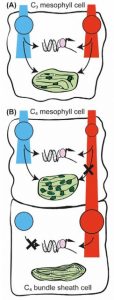 Some plants such as Zea mays partition different components of the photosynthetic pathway in mesophyll cells (MC) and bundle sheath cells (BSC) in a process known as two-cell C4 photosynthesis. For example, light-harvesting reactions carried out by photosystem I and II (PSI and PSII) occur only in the mesophyll cells. Due to the way these cells are arranged in the leaf, they receive different amounts of light. Because bundle sheath cells are located interior to mesophyll cells, the light that reaches the bundle sheath cells is depleted of shorter-wavelength blue light. Hendron and Kelly show that the differential light perception in MC and BSC cells allows the differential accumulation of photosynthetic transcript in the C4 crop Zea mays. Using transcriptomics in de-etiolated seedlings illuminated with blue light or red light, the authors found that blue light promoted the expression of genes that facilitate translation, import and assembly of PSII into the chloroplast; thus, the enrichment of blue-light in the mesophyll cells may reinforce the partitioning of photosynthetic processes. A similar experiment was carried out in Arabidopsis but the differential light responses were not observed. As the authors summarize, “the difference between mesophyll and bundle sheath cells in C4 species may be in part just a trick of the light.” (Summary by Cecilia Vasquez-Robinet) Plant Phys. 10.1104/pp.19.01053
Some plants such as Zea mays partition different components of the photosynthetic pathway in mesophyll cells (MC) and bundle sheath cells (BSC) in a process known as two-cell C4 photosynthesis. For example, light-harvesting reactions carried out by photosystem I and II (PSI and PSII) occur only in the mesophyll cells. Due to the way these cells are arranged in the leaf, they receive different amounts of light. Because bundle sheath cells are located interior to mesophyll cells, the light that reaches the bundle sheath cells is depleted of shorter-wavelength blue light. Hendron and Kelly show that the differential light perception in MC and BSC cells allows the differential accumulation of photosynthetic transcript in the C4 crop Zea mays. Using transcriptomics in de-etiolated seedlings illuminated with blue light or red light, the authors found that blue light promoted the expression of genes that facilitate translation, import and assembly of PSII into the chloroplast; thus, the enrichment of blue-light in the mesophyll cells may reinforce the partitioning of photosynthetic processes. A similar experiment was carried out in Arabidopsis but the differential light responses were not observed. As the authors summarize, “the difference between mesophyll and bundle sheath cells in C4 species may be in part just a trick of the light.” (Summary by Cecilia Vasquez-Robinet) Plant Phys. 10.1104/pp.19.01053



